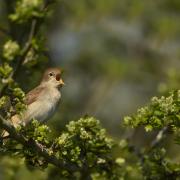Six of the best autumn walks in the county’s countryside taking in both stunning scenery and iconic locations including Pooh Sticks Bridge in Ashdown Forest and a stroll around the Pearl of Sussex.
WORDS & PHOTOS: Fiona Barltrop
Walk 1: Saddlescombe and Devil’s Dyke
SADDLESCOMBE AND DEVIL'S DYKE

One of the South Downs’ most famous beauty spots, Devil’s Dyke, is renowned both for its magnificent views and also its great valley (dyke), from which it takes its name. The steep V-shaped dry valley is the longest and deepest in the country and a most impressive sight. During the Victorian era a cable car was built across it and a funfair established on the top of the hill, in what was once an Iron Age hill fort. A funicular railway was also built on the steep north-facing slope, taking visitors to and from the village of Poynings. All that is visible today are remains of the concrete foundations.
THE WALK The National Trust looks after the land as well as the ancient farmstead of Saddlescombe, situated at the foot of Devil’s Dyke, where you’ll find an information barn, donkey wheel and café. Starting from here, head across the field opposite the farm entrance, cross a stile and bear left up the grassy slope with fine views of the Dyke below on the right. Keep along the path nearest the top edge of Dyke for the best views and follow it round the head of the valley, then bear left up to the car park. Walk along the ramparts on the northern side, and after curving right descend to cross a stile and bear right down to a crossing track/bridleway. Turn left to descend to Poynings, turning right past the Royal Oak pub, then right past the garage back to Saddlescombe. Distance: 3½ miles, with longer options.
Start/parking Parking area opposite Saddlescombe Farm (or alongside railings at entrance), BN45 7DE, grid ref TQ271114
AMBERLEY

Described as the ‘Pearl of Sussex’, Amberley is a picturesque village with many thatched cottages and a 12th century church and castle (now a hotel). It lies at the foot of the South Downs on a low ridge above the River Arun floodplain while the railway station, where this walk starts, is about a mile to the south, just above the river on the scenic Arun valley line. Next door is the popular open-air Amberley Museum. Located in a former chalk quarry, this is a 36-acre open-air site dedicated to the industrial history of the south-east. There’s a pub and tearoom nearby for refreshment after this enjoyable walk, which heads up and over the Downs, returning along the riverbank.
THE WALK Turn left out of the station to the road and right along the pavement opposite. Re-cross the road turning right up a road called High Titten, now on the route of the South Downs Way (SDW). Further up turn left onto a track to continue up the SDW. Leave the SDW (which keeps straight on uphill) bearing right along a wide farm track, soon forking right along a track beside the fence on the right. Follow the bridleway downhill and up the other side, then right along a track and down a lane to North Stoke. The nearby church is well worth a brief detour. Turn right at the phone box and follow the lane to a footpath on the left which leads to the River Arun. Turn right alongside it back to the start. Distance: 4¾ miles.
Start/parking Amberley station car park, BN18 9LR, grid ref TQ026118
HARTING DOWN

The National Trust owned Harting Down, which overlooks the village of South Harting, is situated at the western end of Sussex. It is a beautiful area of chalk downland, affording wonderful views, especially from Beacon Hill, crowned by a trig point and toposcope. This was the site of an Iron Age hill fort and Napoleonic War telegraph station. There are lovely views of the Downs from the fields below on the first part of this walk, followed by a fine high-level stretch along the South Downs Way for the return.
THE WALK The walk starts from South Harting whose most distinctive landmark is its church’s green copper spire, easily spotted from above. Turn right out of the parking area back to the B2141. Keep ahead through the village and follow the road as it bends right. Turn left into Mill Lane then right along a footpath. Cross a lane and continue to another road. Cross and take the right-hand fork through East Harting. Turn right into a drive to Marden Farm, follow the path to a road, left then right along a bridleway. Follow this east to Treyford, then right up the lane to ascend the Downs. Join the South Downs Way heading westwards taking the direct route over Beacon Hill. Cross the B2141 and B2146, and just after the latter turn right back down to South Harting. Distance: 7½ miles, with shorter options.
Start/parking Parking area off access road to recreation ground, to right of B2141 south of church, South Harting, GU31 5QJ, grid ref SU784192
ASHDOWN FOREST

Situated in the High Weald Area of Outstanding Natural Beauty, Ashdown Forest is the largest open access space in the South East. Nearly two thirds of it is heathland, one of the rarest habitats in Britain. This family walk explores the north-eastern part of the Forest, taking in several of the locations made famous in the Winnie-the-Pooh bear books by AA Milne, who lived nearby. Pooh Corner Shop in Hartfield specialises in Winnie-the-Pooh and is full of ‘Pooh-phernalia’. There is also a museum and tearoom here.
THE WALK Ashdown Forest’s many paths and tracks/rides together with a lack of waymarks can make it a bit confusing (compass advised). Also not all are shown on the OS map. A good straightforward option is to head north from the car park to Pooh Bridge, returning the same way. To do so, start by heading past the information panel along a wide track to a clump of pine trees (Gills Lap, Galleons Lap in the Pooh stories, the ‘enchanted place on the very top of the Forest’) and an unusual red sandstone trig point on the right. Not far beyond, in a fenced enclosure on the left, is a memorial plaque to AA Milne and his illustrator, EH Shepard. A fine viewpoint. Carry on northwards or for an anti-clockwise circuit retrace your steps a few paces and turn left down to Quarry car park. Then head east to join the Wealdway, follow it north through Five Hundred Acre Wood then turn left to the B2026. Continue to Pooh Sticks Bridge, then south back to the car park. Distance: 3¼ miles (or 5 miles for circuit).
Start/parking Gills Lap car park, TN7 4EU, grid ref TQ467315
BRIGHTLING

Located in the peaceful countryside of the High Weald AONB, the village of Brightling is famous for its collection of follies built by one John ‘Mad Jack’ Fuller (1757-1834), the local squire, an MP and a philanthropist, who supported both the arts and science. The family wealth came from the Sussex iron industry. The follies (which earned him his nickname) include the pyramid in the churchyard where he is buried, an obelisk, tower, temple, observatory, and a cone known as the Sugar Loaf. He also had the wall surrounding Brightling Park built which provided valuable work at a time of high unemployment, bought Bodiam Castle to save it from demolition and financed the building of the first lighthouse at Belle Tout on the Sussex coast.
THE WALK Turn right out of the church to the road junction, then follow a footpath south-east, turning right past the tower down to the road. Continue on a bridleway southwards, turning off right along a footpath down to Mansbrook Wood. Head north-west, then south-west to the road near Hook’s Farm House, detour left to visit the Sugar Loaf, then follow the path along the edge of woodland continuing along the road back to the start. Distance: 4¼ miles.
Start/parking Roadside layby adjoining phone box on north side of church, TN32 5HJ, grid ref TQ683210
CUCKMERE RIVER

Situated at the eastern end of the South Downs beside the meandering Cuckmere River and just a few miles inland from the coast, Alfriston is one of the loveliest of all Sussex villages. Noted for its beautiful church, village green, old pubs and tea shops, it’s an ideal base for walking, with a variety of scenery to explore.
THE WALK For an easy 2½ walk simply cross the footbridge and follow the riverbank down the east side to Litlington, cross the bridge and return along the west bank. Or for a longer 7-mile walk continue from Litlington along the combined route of the South Downs Way/Vanguard Way via Friston Forest and West Dean to Exceat, then follow either riverbank back.
Start/parking Willows long stay car park, Alfriston, BN26 5UQ, grid ref TQ521033



























